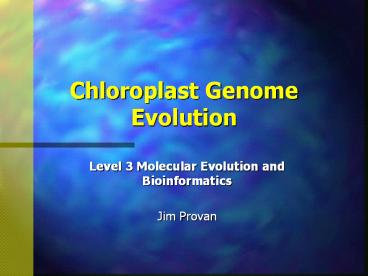Chloroplast Genome Evolution - PowerPoint PPT Presentation
Title:
Chloroplast Genome Evolution
Description:
Carries out photosynthesis. Contains own genome. Believed to be of endosymbiotic origin ... Photosynthesis. Metabolism. The inverted repeat (IR) Ranges from 5bk ... – PowerPoint PPT presentation
Number of Views:1588
Avg rating:3.0/5.0
Title: Chloroplast Genome Evolution
1
Chloroplast Genome Evolution
- Level 3 Molecular Evolution and Bioinformatics
- Jim Provan
2
References
- Douglas SE (1998) Plastid evolution origins,
diversity, trends Current Opinion in Genetics
and Development 8 655-661 - Sugiura M (1995) The chloroplast genome Essays
in Biochemistry 30 49-57 - Gray MW (1993) Origin and evolution of organelle
genomes Current Opinion in Genetics and
Development 3 884-890
3
The chloroplast
- Carries out photosynthesis
- Contains own genome
- Believed to be of endosymbiotic origin
- Phylogenetically related to cyanobacteria
4
Algal lineages
Primary (Double membrane) Secondary (Thre
e or more membranes)
Cryptophytes Heterokonts Haptophytes
Dinoflagellates Apicomplexans
Euglenoids Chlorarachniophytes
5
Monophyly of primary plastids - chloroplast
evidence
- Phylogeny of SSU rRNA based on good sample of
both cyanobacteria and plastids - Also supported by
- tufA
- atpB
- rpoC1
- psbA
6
Monophyly of primary plastids - mitochondrial and
nuclear evidence
- Tree based on five mitochondrial genes shows
strong support for monophyly - Nuclear genes
- ?-tubulin - inconclusive
- rRNAs - poorly resolved
- RPB1 - rejects
- TPI / EF-1? - weak support
- GAPDH / actin - better support
7
Secondary plastids
- Plastid SSU rDNA tree shows that euglenophytes
and chloroarachiophytes associate with green
algae and that heterokonts, cryptophytes and
haptophytes associate with red algae - Studies on nucleomorphs also confirm ancestry of
cryptophytes and chloroarachniophytes
8
The chloroplast genome
- Sequenced chloroplast genomes range from 70kb -
201kb - Variation in length mainly due to presence of
inverted repeat (IR) - Generally 100-250 genes
- Gene expression
- Photosynthesis
- Metabolism
9
The inverted repeat (IR)
- Ranges from 5bk to 76kb in length
- IR contains rRNA genes plus others
- None in brown algae (5kb)
- 10 in tobacco (25kb)
- 40 in geranium (76kb)
- Present in
- Land plants (exc. legumes)
- Chlorophytes
- Chromophytes
- Partial in conifers
10
Chloroplast genome evolution
- Rapid and massive reduction in number of genes
- Transferred to nucleus
- Lost
- 80-90 of plastid proteins are encoded in nucleus
- Great overlap in gene content suggests that last
common ancestor of cpDNA had 300 genes
11
Gene loss in chloroplast evolution
- 45 genes present in all genomes
- Unique losses (68) outnumbered by parallel losses
(122) - Confirms that ancestral plastid genome was
already highly reduced from that of cyanobacteria
12
Chloroplast gene content
Group 1 Gene expression Photosynthesis Metabolism
Rhodophytes s. l. Glaucocystophytes
Group 2 Gene expression Photosynthesis Metabolism
Chlorophytes s. l
Group 4 Gene expression Photosynthesis Metabolism
Yet to be discovered (cf. Hydrogenosomes in
mitochondria)
Group 3 Gene expression Photosynthesis Metabolism
Non-photosynthtic Chlorophytes (e.g. Epifagus)
and apicomplexans
13
Chloroplast genes (excluding ycf)
Total
101-107
40
82
113-166
181
Gene expression rRNA tRNA r-protein
Other
4 30-32 2-21 5-6
4 17 15 2
3 27 21 4
3 28-36 21-44 6-9
3 35 47 18
Photosynthesis RuBisCo/thylakoid ndh
29-30 11
- -
26 -
31-48 -/10
53 -
1-5
2
1
7-14
25
Metabolism/misc.
18-21
6
149
-/1/3
-
Introns































